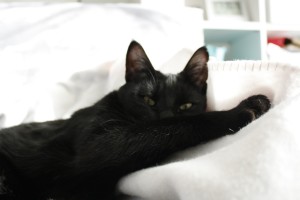 You’ve decided to welcome a little kitten or cat into your home. At first, everything is fine — purrs, chasing the red dot and playful tumbles fill at least a little part of your lives. You buy the best cat food, listen to your vet and make sure that your home is welcoming to your new feline friend.
You’ve decided to welcome a little kitten or cat into your home. At first, everything is fine — purrs, chasing the red dot and playful tumbles fill at least a little part of your lives. You buy the best cat food, listen to your vet and make sure that your home is welcoming to your new feline friend.
And then the furry little beast starts to climb your curtains or hang on the screen, causing damage to both.
The pitter patter of little cat feet at 3 a.m. lead to the sharp, claw-filled pounce on your feet at night.
Minor things, yes, but they can be expensive over time. When I was younger, my mother had refinished the banister to the upstairs, stripping down the yellowed, off-white paint down to the rich mahogany wood beneath. She spent days stripping and re-staining while two dogs, three kids and a black cat named Snow remained underfoot — loud, demanding and yes, full of love. When she was finished, she showed off her work, proud of her effort, and we kids became excited for her, although I doubt we really understood exactly why.
And then Snow, in all her feline hunter glory, decided that the freshly refinished banister needed to become her latest conquest. In front of the entire family, she bounded up onto the banister and clawed at the slick surface as she began to lose her grip. My mom acted quickly, but not before about half the banister was gouged with little claw marks. She placed the cat on the ground, sighed in frustration and made us some dinner. Early the next morning, I found her at the stairs again, beginning the process of sanding and refinishing yet again.
Surprisingly, my mother didn’t remove Snow’s front claws. Over time, I learned a few of the reasons why she chose not to.
Reason Not To Declaw #1 — It is Serious Surgery
Removing the cat’s claw means that you are removing them — not giving your cat a manicure. It involves serious surgery, and there are inherent risks that come with it. The cat’s claws aren’t like a fingernail at all; they are actually adhered to the bone of the cat’s foot, meaning that in order to remove them, the vet has to essentially amputate a portion of your cat’s toes!
Reason Not to Declaw #2 — Clawing is a Natural Act
Truth be told, cats don’t claw things because they dislike you or the object of their “attack.” They’re not doing it to get back at you. Clawing is an instinctual act that helps to maintain claws, stretch their muscles and give them a bit of enjoyment.
Reason Not to Declaw # 3 — The Claws are Your Cat’s First Line of Defense
Even if you keep your cat indoors, there will be times when it will need to defend itself, either from other animals, children or even an intruder in your home. You want to make sure that your home and the environment that your cat lives in is safe and happy. Why would you want to take away a possible line of defense for those few times that it might not be?
 Reason Not to Declaw # 4 — There are So Many Other, Better Options
Reason Not to Declaw # 4 — There are So Many Other, Better Options
Perhaps the most practical reason not to de-claw your cat is because there are so many other alternatives. If you’re worried about your cat ruining your furniture, there are a number of proactive things you can do to lessen the chance of that happening. For example:
- Keep your cat’s claws trimmed. It’s easy to do when your cat is relaxed and unafraid. Ask your vet to show you how to do it.
- Give your cat things that he or she is allowed to scratch. Scratching posts are a great investment. Cats don’t usually want to get in trouble — they just want an easy place to stretch out and keep their claws in top shape. Make sure you provide them with good alternatives.
- Play with your cat! Believe it or not, clawing is a way for your cat to relax and unwind when it is feeling a little nervous. Playing with your cat in a relaxed fashion is a great way to help ease their stress and prevent them from excessively clawing your furniture.
So as you can see, leaving your cat’s claws alone is a good decision to make. What are your thoughts?


http://www.softpaws.com/